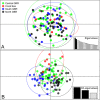Connectivity in grey reef sharks (Carcharhinus amblyrhynchos) determined using empirical and simulated genetic data
- PMID: 26314287
- PMCID: PMC4551972
- DOI: 10.1038/srep13229
Connectivity in grey reef sharks (Carcharhinus amblyrhynchos) determined using empirical and simulated genetic data
Abstract
Grey reef sharks (Carcharhinus amblyrhynchos) can be one of the numerically dominant high order predators on pristine coral reefs, yet their numbers have declined even in the highly regulated Australian Great Barrier Reef (GBR) Marine Park. Knowledge of both large scale and fine scale genetic connectivity of grey reef sharks is essential for their effective management, but no genetic data are yet available. We investigated grey reef shark genetic structure in the GBR across a 1200 km latitudinal gradient, comparing empirical data with models simulating different levels of migration. The empirical data did not reveal any genetic structuring along the entire latitudinal gradient sampled, suggesting regular widespread dispersal and gene flow of the species throughout most of the GBR. Our simulated datasets indicate that even with substantial migrations (up to 25% of individuals migrating between neighboring reefs) both large scale genetic structure and genotypic spatial autocorrelation at the reef scale were maintained. We suggest that present migration rates therefore exceed this level. These findings have important implications regarding the effectiveness of networks of spatially discontinuous Marine Protected Areas to protect reef sharks.
Figures




Similar articles
-
Genetic structure and signatures of selection in grey reef sharks (Carcharhinus amblyrhynchos).Heredity (Edinb). 2017 Sep;119(3):142-153. doi: 10.1038/hdy.2017.21. Epub 2017 Apr 19. Heredity (Edinb). 2017. PMID: 28422134 Free PMC article.
-
Contrasting movements and connectivity of reef-associated sharks using acoustic telemetry: implications for management.Ecol Appl. 2015 Dec;25(8):2101-18. doi: 10.1890/14-2293.1. Ecol Appl. 2015. PMID: 26910942
-
Large-scale movement and reef fidelity of grey reef sharks.PLoS One. 2010 Mar 10;5(3):e9650. doi: 10.1371/journal.pone.0009650. PLoS One. 2010. PMID: 20224793 Free PMC article.
-
Drivers of abundance and spatial distribution of reef-associated sharks in an isolated atoll reef system.PLoS One. 2017 May 31;12(5):e0177374. doi: 10.1371/journal.pone.0177374. eCollection 2017. PLoS One. 2017. PMID: 28562602 Free PMC article.
-
Larval dispersal and movement patterns of coral reef fishes, and implications for marine reserve network design.Biol Rev Camb Philos Soc. 2015 Nov;90(4):1215-47. doi: 10.1111/brv.12155. Epub 2014 Nov 25. Biol Rev Camb Philos Soc. 2015. PMID: 25423947 Review.
Cited by
-
Genetic structure and signatures of selection in grey reef sharks (Carcharhinus amblyrhynchos).Heredity (Edinb). 2017 Sep;119(3):142-153. doi: 10.1038/hdy.2017.21. Epub 2017 Apr 19. Heredity (Edinb). 2017. PMID: 28422134 Free PMC article.
-
Mobile marine predators: an understudied source of nutrients to coral reefs in an unfished atoll.Proc Biol Sci. 2018 Mar 28;285(1875):20172456. doi: 10.1098/rspb.2017.2456. Proc Biol Sci. 2018. PMID: 29563260 Free PMC article.
-
Sequencing and characterization of the complete mitochondrial genome of Japanese Swellshark (Cephalloscyllium umbratile).Sci Rep. 2017 Nov 10;7(1):15299. doi: 10.1038/s41598-017-15702-0. Sci Rep. 2017. PMID: 29127415 Free PMC article.
-
Variability in multiple paternity rates for grey reef sharks (Carcharhinus amblyrhynchos) and scalloped hammerheads (Sphyrna lewini).Sci Rep. 2017 May 8;7(1):1528. doi: 10.1038/s41598-017-01416-w. Sci Rep. 2017. PMID: 28484261 Free PMC article.
-
Seasonality, long-term trends and co-occurrence of sharks in a top predator assemblage.PLoS One. 2025 Feb 26;20(2):e0318011. doi: 10.1371/journal.pone.0318011. eCollection 2025. PLoS One. 2025. PMID: 40009580 Free PMC article.
References
-
- Heithaus M. R., Frid A., Wirsing A. J. & Worm B. Predicting ecological consequences of marine top predator declines. Trends Ecol. Evol. 23, 202–210 (2008). - PubMed
-
- Myers R. A., Baum J. K., Shepherd T. D., Powers S. P. & Peterson C. H. Cascading effects of the loss of apex predatory sharks from a coastal ocean. Science 315, 1846–1850 (2007). - PubMed
-
- Wirsing A. J., Heithaus M. R., Frid A. & Dill L. M. Seascapes of fear: evaluating sublethal predator effects experienced and generated by marine mammals. Mar. Mamm. Sci. 24, 1–15 (2008).
Publication types
MeSH terms
LinkOut - more resources
Full Text Sources
Other Literature Sources

